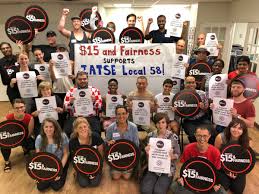The Liberal government’s 2022 budget is a budget for Bay Street, not for working-class Canadians. It’s full of incentives and subsidies for big business, including fossil fuel companies and private developers. It has a housing program that will leave thousands without homes, and a weak and slowly implemented dental program that won’t cover everyone. The budget says nothing about pharmacare, nothing about the failed for-profit long-term care system, and it doubles down on expanding fossil fuel production. Working-class Canadians have clear and pressing needs coming out of two years of a pandemic, a cost-of-living crisis, and ongoing climate disaster. On all of the above and more, this budget fails to deliver.
The underlying aim of the budget is to get Canada “back to normal” at a time in world history when the “normal” of the past several decades brought record inequality and put the planet on course for a climate-change disaster. A return to that kind of “normal” is not particularly appealing and is a fantasy, given the changed world of war and inter-imperialist tensions.
The Financial Post contentedly proclaimed: “Chrystia Freeland finally gets serious with her second budget,” and that “Paul Martin needed two budgets to become Paul Martin.” The Post correctly points out the way that both finance ministers acted on behalf of big business to give the latter what they wanted. Martin’s second budget, in 1995, would be infamous for its unprecedented and savage cuts to public services and a huge reorienting of Canada’s economy in the direction of big business in the ascendency of the era of neoliberalism. Martin furthered and deepened those cuts in the subsequent years, capping off and locking in his triumph with a $100 billion tax cut in 2000, overwhelmingly gifted to Canada’s richest businesses and individuals. This was supposed to stimulate investment and productivity growth, but 30 years later Canada has one of the lowest growth rates in the developed capitalist world, and big businesses, already flush with cash from tax cuts and super-profits, claim they need even more support and incentives to invest.
Housing
The budget’s number-one headline is a commitment to funding for housing — $10 billion over the coming five years. Only a portion of that money is actually being spent on housing itself. The biggest chunk, $4 billion, is for a “housing accelerator fund” that aims to incentivize municipalities to streamline planning processes, making those even friendlier to big property developers. It also creates a new Tax-Free Savings Account for first-time homebuyers, which in the short term may help some middle-class homebuyers get into the housing market, but it will only drive prices even higher in the long term.
The figure of $10 billion sounds like a lot, but when you average this out over the population it amounts to $53 per person per year, while the average home price in Canada has risen to $816,720 as of February 2022 — an increase of over 20 percent from the same time just one year prior. Vancouver city councillor Jean Swanson noted that, if the $10 billion is distributed across the country in proportion to population, it means about $177 million over 5 years for Vancouver. Swanson estimates there are over 2,000 homeless people in Vancouver and one unit of modular housing costs between $300,000 and $500,000. This means that $600 million to $1 billion will be required to build enough modular homes for every homeless person, or 3.5 to six times the amount of money promised in the budget. And that assumes that all the money is spent to actually build homes, which is not the case. As Swanson says, it’s “basically a pittance that probably guarantees homelessness will continue.”
Between 1974 and 1986 the federal government funded non-profit groups, co-operatives and municipalities in order to provide affordable housing. More than 220,000 units of non-profit and co-operative housing were built. The Liberal team of Jean Chrétien and Paul Martin came in and in 1994-95, they cut all this funding as part of financing the largest tax cut in a generation for big business and the rich. It was claimed that the “liberated” private sector would fill the void left by the end of public housing construction. But today Canada has the largest gap between income and housing prices in the G7 according to the OECD, and more than 235,000 Canadians experience homelessness every year according to Statistics Canada. If the federal government had continued funding affordable housing construction from 1994 at the same rates as 1974-1986, today Canada would have at least 500,000 additional affordable homes. This is the root of the housing crisis in Canada.
Instead of reversing course from the failed program of relying on the for-profit system to build housing, this budget doubles down on it and offers pittances, fractions of the $10 billion total, on actual affordable housing programs. Private developers exist to make profits, not provide homes that people need. They are busy making huge profits building luxury condos; the construction sector is currently working at full capacity. Pouring more money onto the fire of private developers will not produce different results.
Property speculators are driving up sales prices as they make 22 percent of purchases. They are also buying up rental stock and evicting sitting tenants and jacking up rents by 50 percent or more. A third of all housing in Canada is owned by multiple-property owners.
What is needed is a massive program of government-built and publicly owned housing: non-market housing with rents based on ability to pay. The government has the capacity to hire and train the necessary construction workers and has access to public lands on which to build housing. In many places, slumlords who profit from extremely low-income tenants while providing disgusting and decrepit housing should have their properties expropriated without compensation, and new public housing built in its place. A massive creation of non-market housing would reduce the possibilities to profit from housing and reduce the tidal wave of speculative housing purchases. This would, in turn, slow or even reverse the massive price increases of the past several years and make housing more affordable for everyone else, including through lower rents.
Climate and military
It’s clear that the Liberal government has no intention to transition away from fossil fuels. The day before the budget was presented the federal government approved the Bay du Nord project, which will drill nearly 200,000 barrels per day off the northeast coast of Newfoundland. In the budget itself, rather than cutting existing subsidies to the oil and gas industry, the government decided to give more public money to the industry by announcing $2.6 billion in tax credits for companies that invest in experimental and unproven “carbon capture technology,” or that try to reduce the emissions associated with fossil fuel production. This is part of the sleight of hand of “net-zero,” through which governments can claim to be reducing emissions while they expand fossil fuel production. Canadian oil and gas, wherever it is burnt, adds to climate change.
The latest report from the Intergovernmental Panel on Climate Change is clear that humanity faces runaway catastrophe unless all fossil fuel production is sharply reduced, but the Liberal government is doing the exact opposite.
There is a desperate need for a just transition to a green economy in which fossil fuel companies are wound down, and in which the industry’s workers are guaranteed new jobs as part of a massive construction of green infrastructure including renewable energy, public transit, and redesign of our cities. A majority of Canadians, including a majority of fossil fuel workers, want to be part of that just transition, to have well-paid and rewarding jobs rebuilding a sustainable economy and livable cities. This budget was not only a missed opportunity but a slap in the face to the majority of Canadians, as the federal government continues to spend billions of dollars to expand fossil fuel production, including on the Trans Mountain pipeline.
Global militaries are among the worst drivers of climate change, and military emissions are excluded from a country’s emission targets. The 2022 budget increases military spending by $8 billion over the next five years. This is in addition to the Liberals’ announcement a week earlier of a new $19 billion purchase of F-35 fighter jets from the United States. $500 million is earmarked to purchase new weapons to send to the war in Ukraine. New submarine and frigate purchases are planned. Even these increases won’t appease NATO warmongers, who are demanding yet more military spending from Canada to meet its NATO-appointed target of 2 percent of GDP. None of this new spending will address any real security threat to working-class Canadians, who are more at risk today of dying in a heat wave than in a military conflict. All this new military spending is about defending Western imperialist interests abroad when there is a desperate need for more to go towards good homes, jobs, and a healthy environment for ordinary people.
Health care
New Democratic Party leader Jagmeet Singh says that his party supports the budget, although they have some complaints. But what exactly did the New Democrats get in exchange for their support? The budget includes $5.3 billion over five years for a means-tested program that will provide dental coverage to families making under $90,000 per year. This is a valuable reform that will provide a lot of people dental coverage, but it is clearly a limited and non-universal plan. And what about pharmacare? The Liberal government ran on pharmacare in 2019 but since then nothing, including in the 2022 budget.
The biggest scandal is the lack of any action on the for-profit long term care system. For-profit care homes make money by exploiting vulnerable Canadians while failing to provide a decent level of care. These institutions were clearly exposed during the pandemic as they failed to act on COVID and were death traps for 14,000 seniors. There is a clear and obvious case to integrate the long-term care system into the public healthcare system, and the lack of any mention of this in the budget is shameful.
More help for big business
Big business in Canada was, as a whole, happy to go along with the massive spending and stimulus during the pandemic lockdowns, especially since most of that money was given directly to them. But now that the continued failure of the private sector to grow the economy has resulted in runaway inflation, they are looking to get more support and incentives from the government even as it cuts back the scale of spending. And the government is happy to give it to them in the form of the $15 billion investment in the Canada Growth Fund, designed to attract private capital investment to Canada. Much like the Canada Infrastructure Bank created in 2020, the Canada Growth Fund will attract private investors by promising that the public will take on all the risks of the investments.
The budget announced a one-time 15 percent tax on excess pandemic profits for the big banks and financial institutions, as well as an ongoing 1.5 percentage point hike (to 16.5 percent) to their corporate tax rates for profits over $100 million. (A 2021 Liberal campaign promise to raise the rate to 18 percent for profits over $1 billion was not included.) While it sounds nice, this is a pinprick when compared to the colossal profits of the big banks over the pandemic years. In 2021 alone, the Big Six banks made a combined $57 billion in profit, $18.8 billion of which was spent on executive bonuses. They will be relieved to have gotten away with such a small tax. These private banks are parasitic institutions and should be expropriated and placed under democratic control. Those $57 billion in profits could be spent on things like public housing and mass transit infrastructure instead of going into the pockets of rich executives, perhaps to purchase a mega-yacht recently taken from one of their fellow oligarchs in Russia.
The NDP made a bad deal with little to show for it
If all the NDP was going to get was this moderate dental program and a few other small tweaks, there was no need for them to sign the multi-year supply and confidence agreement with the Liberal Party that gives up all their leverage. The only power that the NDP had over the Liberals was the threat of calling an election. The primary motivation for the NDP in signing the agreement is to avoid an election for which the leadership is unprepared. But the moment they signed it, any power they did have vanished. Now the Liberals can pass budgets with a failed housing plan, increased military spending, new fossil fuel subsidies, and the NDP can’t put up any credible resistance, since they’ve agreed in advance to support it.
While the NDP will try to take credit for Canadians’ relatively healthier teeth, the Liberals will too. The NDP will now be associated with this government and this budget, and their reputation will be tarnished in the eyes of working-class Canadians who are struggling and have not received the relief they need.
If the NDP had not signed the agreement with the Liberals, they could have strongly criticized this budget and presented alternative proposals that would actually address ordinary people’s concerns. In the end they could still have agreed to pass this budget with the dental plan as a compromise, but in the process, they would have strengthened their position politically and built credibility as a party that will fight for working people.
For its part, the Conservative Party is decrying the so-called NDP–Liberal budget as “irresponsible” for not cutting spending enough to control inflation, not including enough tax cuts, and not doing enough to increase housing supply. They are appealing to the struggles facing working-class people to make ends meet and to get affordable housing, but they say the problem is taxes and big government, raising the spectre of “backdoor socialism” in the NDP–Liberal agreement. (If only socialism were that easy!) But beyond the partisan spin and parliamentary manoeuvring, the major influencers and bankrollers of the Conservative Party will largely agree with the analysis of the Financial Post. This is a “serious” budget made to appeal to the demands of big business, not for the needs of the working class.
A socialist budget?
The real question is not what’s in the budget but what’s not in it. Nothing about a just transition to phase out fossil fuels while creating high quality jobs building green infrastructure. Nothing but smoke and mirrors to deal with the housing crisis. Nothing at all to address the chronic problems with the healthcare system, including pharmacare and especially long-term care, which have been exposed by the pandemic.
A real socialist budget would expropriate the banks, fossil fuel companies, big manufacturers, resource extractors, property developers, telecom, insurance, and private transport — and it would do so without compensation to their current owners, except in cases of proven need such as for small-time shareholders. It’s abundantly clear that an economy run in the interests of profits for the tiny elite is incapable of solving the economic and ecological crisis facing the world today or of securing peace. The time has come for rational democratic planning of the productive power and resources of society, to avoid further disaster and to build a just and prosperous society for the majority.




